2025年中考英语二轮复习课件——名词
文档属性
| 名称 | 2025年中考英语二轮复习课件——名词 |  | |
| 格式 | pptx | ||
| 文件大小 | 13.5MB | ||
| 资源类型 | 试卷 | ||
| 版本资源 | 通用版 | ||
| 科目 | 英语 | ||
| 更新时间 | 2025-03-03 20:10:39 | ||
图片预览


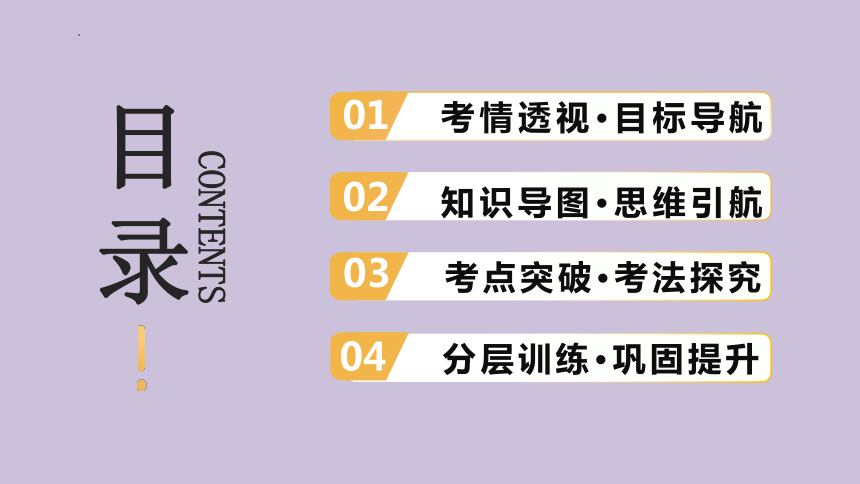
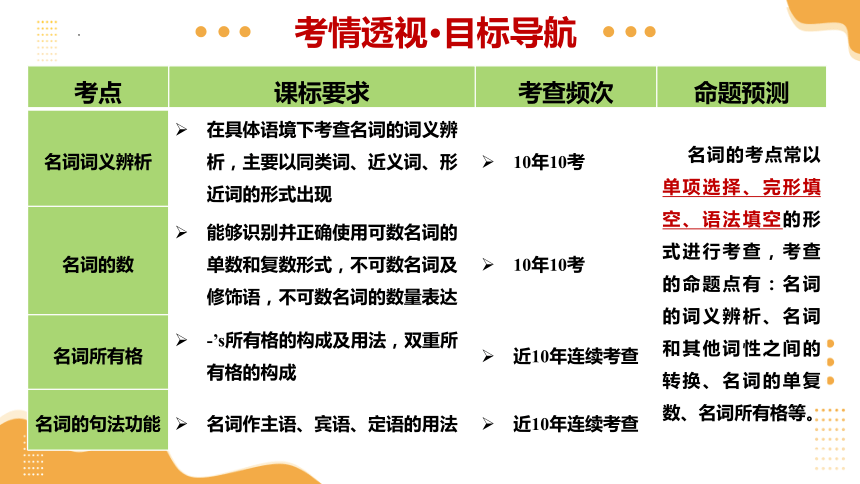
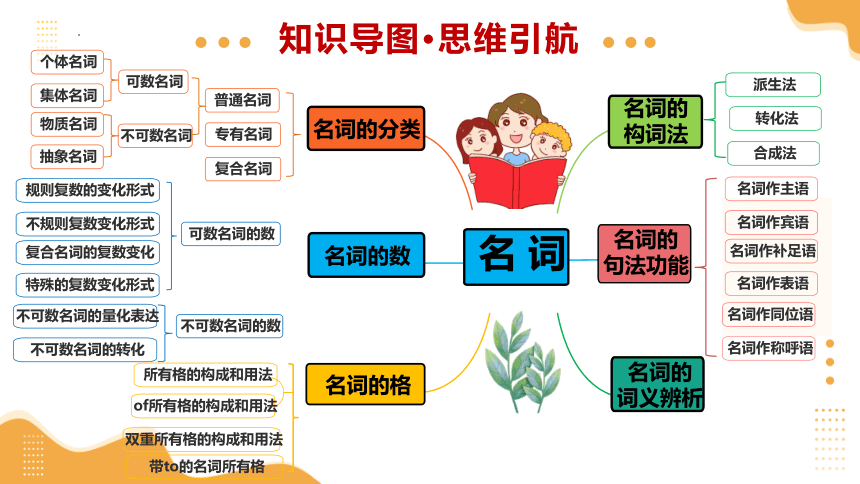

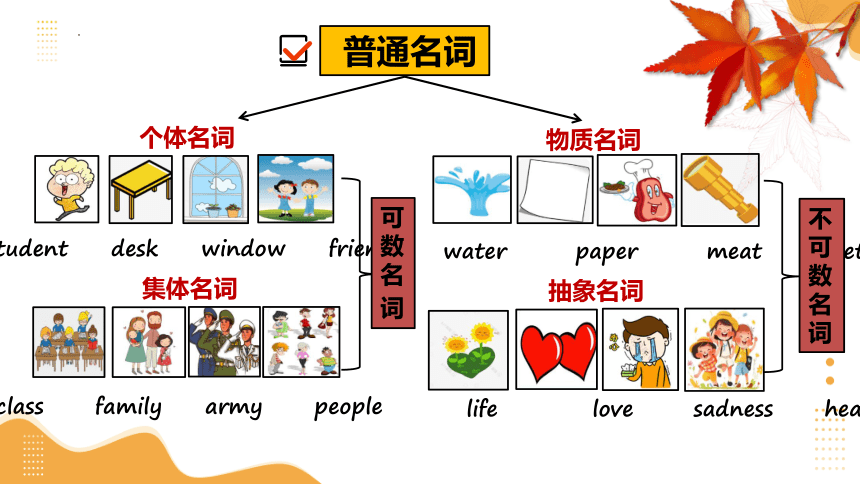

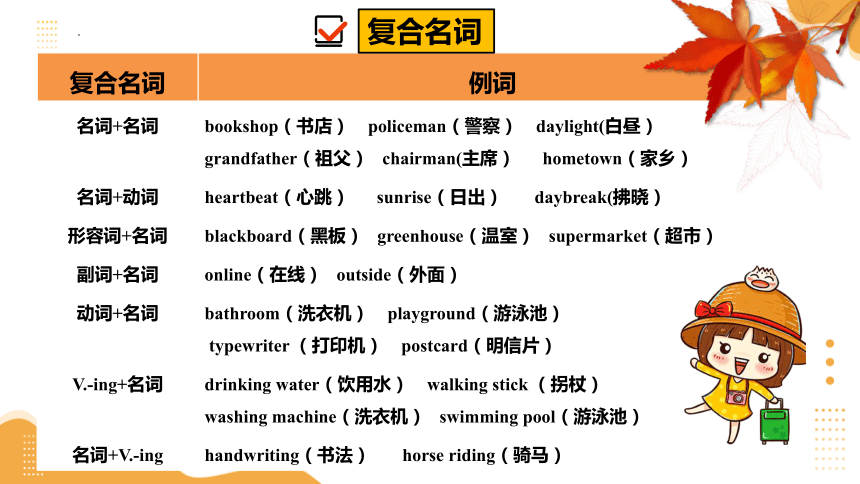

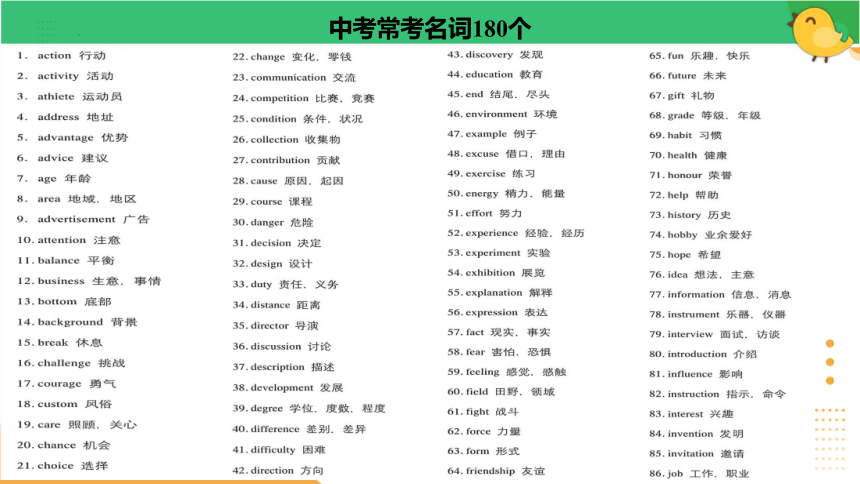
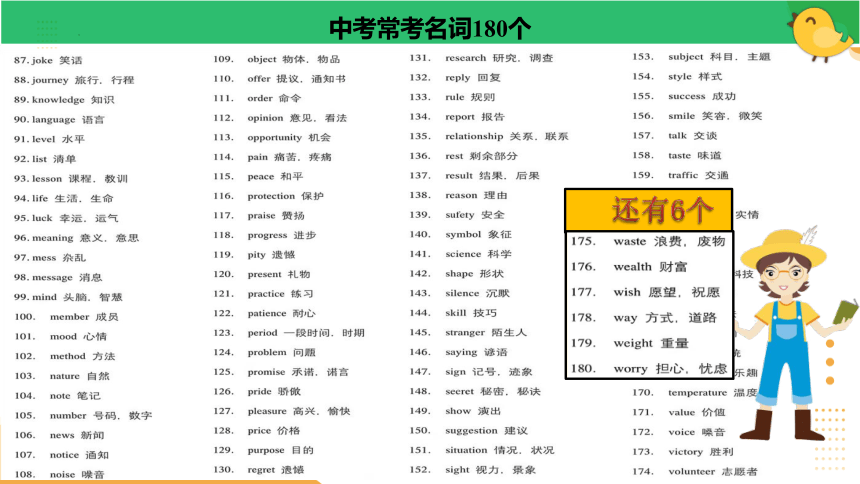
文档简介
(共43张PPT)
专 题 01 名词
中考复习
专 题 01 名词
一轮复习
英
语
01
考情透视·目标导航
02
知识导图·思维引航
03
考点突破·考法探究
04
分层训练·巩固提升
目录
CONTENTS
考点 课标要求 考查频次 命题预测
名词词义辨析 在具体语境下考查名词的词义辨析,主要以同类词、近义词、形近词的形式出现 10年10考 名词的考点常以单项选择、完形填空、语法填空的形式进行考查,考查的命题点有:名词的词义辨析、名词和其他词性之间的转换、名词的单复数、名词所有格等。
名词的数 能够识别并正确使用可数名词的单数和复数形式,不可数名词及修饰语,不可数名词的数量表达 10年10考
名词所有格 -’s所有格的构成及用法,双重所有格的构成 近10年连续考查
名词的句法功能 名词作主语、宾语、定语的用法 近10年连续考查
考情透视·目标导航
02
知识导图·思维引航
名 词
专有名词
普通名词
可数名词
复合名词
名词的
句法功能
名词的
词义辨析
名词的分类
名词的数
名词的格
不可数名词
个体名词
集体名词
物质名词
抽象名词
可数名词的数
不可数名词的数
规则复数的变化形式
不规则复数变化形式
复合名词的复数变化
特殊的复数变化形式
不可数名词的量化表达
不可数名词的转化
所有格的构成和用法
of所有格的构成和用法
双重所有格的构成和用法
名词作主语
名词作宾语
名词作补足语
名词作表语
名词作同位语
名词作称呼语
派生法
转化法
带to的名词所有格
合成法
名词的
构词法
考点突破·考法探究
考点1:名词的分类
个体名词
专有名词
普通名词
可数名词
不可数名词
集体名词
物质名词
抽象名词
复合名词
普通名词
个体名词
student desk window friend
class family army people
集体名词
可
数
名
词
物质名词
water paper meat metal
life love sadness health
抽象名词
不可
数
名
词
专有名词
①表示人名、头衔或者尊称的专有名词:
Mark Twain马克·吐温 Professor Li 李教授
②表示团体机构或会议的专有名词:
The United Nations 联合国 Group of Twenty 二十国集团
③表示月份、星期、节日的专有名词:
Saturday星期六 Spring Festival春节
④表示国名、地名、山河名的专有名词:
China中国 Chinatown 唐人街
⑤由普通名词构成的专有名词:
the Summer Palace 颐和园 The Great Wall 长城
复合名词 例词
名词+名词 bookshop(书店) policeman(警察) daylight(白昼)
grandfather(祖父) chairman(主席) hometown(家乡)
名词+动词 heartbeat(心跳) sunrise(日出) daybreak(拂晓)
形容词+名词 blackboard(黑板) greenhouse(温室) supermarket(超市)
副词+名词 online(在线) outside(外面)
动词+名词 bathroom(洗衣机) playground(游泳池)
typewriter (打印机) postcard(明信片)
V.-ing+名词 drinking water(饮用水) walking stick (拐杖)
washing machine(洗衣机) swimming pool(游泳池)
名词+V.-ing handwriting(书法) horse riding(骑马)
复合名词
考点突破·考法探究
考点2:名词的词义辨析
命题分析:
在中考中,对于名词的考查,更多集中在具体语言环境下 上。综合分析近几年的中考真题,总结中考常考名词180个以及易混易错名词辨析,供大家复习使用。
名词词义的辨析
中考常考名词180个
中考常考名词180个
还有6个哦!
中考易混易错点辨析(高频易混名词)
Group 1 family family 指的是家庭或家庭成员,与居住地无关。
home home 指某人出生以及成长的环境或与某人一起居住的地方。
house house 强调人们居住的建筑物本身。
address address 指人们生活、工作地点的市镇、街区、门牌号和电话、传真号等,即通讯地址。
Group 2 noise noise 通常指不悦耳的、令人烦恼的嘈杂声,隐含贬义。
voice voice 指人说话或唱歌时发出的声音。可引申为人的呼声或意见。
sound sound 普通用词,含义笼统,指人们能听到的各种声音,无褒贬色彩。
Group 3 message message 指通过书写、谈话和信号等方式所进行的通讯“信息”。
news news 特指报纸、电台或电视等传播媒体所发布的信息。
information information 指通过各种途径如观察、阅读或与人交往所获得的任何信息,但不一定都准确。
Bob has a big family. 鲍勃有一个大家庭。
I'll call you as soon as I get home. 我一到家就给你打电话。
Look at that beautiful house! 看那座漂亮的房子。
My address is 123 Main Street. 我的住址是123 Main Street。
Don't make a noise. 不要制造噪音。
It's good to hear your voice. 听到你的声音真好。
The sound of the bell means class is over. 铃声意味着下课。
We've had an urgent message saying that your father's ill.
我们得到个紧急消息说你父亲病了。
The news really made my day.
这消息确实使我一天都很愉快。
The book contains much useful information.
这本书包含许多有用的资料。
中考易混易错点辨析(高频易混名词)
Group 4 job job 是可数名词,指一件必须做的工作,或有报酬的工作,也可指职业,多用于口语中。
work work 是不可数名词,指工作、劳动、职业、操作、运转等,这个词是一般用语,可用于各种场合。
Group 5 advice advice 普通用词,侧重依据个人经验、学识和正确判断而提出的忠言,是不可数名词。
suggestion suggestion 普通用词,语气比advice婉转客气。着重为改进工作、解决困难等提出的建议,有时含所提建议不一定正确,仅供参考的意味。是可数名词,除了表示建议外,还有“暗示,表明”的。
Group 6 cause cause 指直接导致事情发生的原因,与所发生的事有因果关系,常用the cause of搭配。
reason reason 强调指从逻辑推理上得出的结论性原因,不是直接说明起因,常用the reason for搭配。
excuse excuse 指为自己辩解,希望得到谅解时所提出的种种理由,是借口性的理由。
He is a teacher, so his job is to teach.
他是一名教师,所以他的工作是教书。
He has got a lot more work on the book.
这本书他还有很多工作要做。
Tom gave me some very sensible advice.
汤姆给了我一些非常合理的建议。
The suggestion didn't go down very well with her boss.
她的老板对这个建议不太感兴趣。
Drunk driving is the cause of the accident.
酒驾是这起事故的原因。
The reason for my absence was that I was ill.
我没来的原因是我生病了。
That is an excuse for your absence.
那是你没来的一个借口。
中考易混易错点辨析(高频易混名词)
Group 7 situation situation 指物体在其周围环境中所处的位置或状态,侧重地点或场所的环境特征,也可指明确具体的环境情况或处境。
scene scene 常指真实事件或虚构故事发生的地点。
condition condition 一般强调产生影响的原因或环境,复数形式指笼统的情况。
position position 多指物体相对于其他物体所处的位置或状态。还可以指社会地位较高,工作较为庄重,领取工资的职位。
Group 8 note note 指内容直截了当的短信或便条,正式或非正式均可。
notice notice 指用以宣传某事的发生或传达某种指示的通知。
sign sign 普通用词,指人们公认事物的记号,也可指某种情况的征兆。
Group 9 mark mark 普通用词,含义广泛。既可指方便于辨认而有意做的标记,又可指自然形成的标记或有别于他事物的特征。
signal signal 指为某一目的而有意发出的信号。
symbol symbol 指作象征或表达某种深邃意蕴的特殊事物。
She’s in a hopeless situation. 她处在一种无助的境地。
Firefighters came on the scene soon where a fire had broken out. 消防员很快到达了火灾现场 。
The car is in very good condition. 这辆汽车情况良好 。
The house is in a good position. 这所房子在一个好位置 。
Students should take notes during the lectures.
学生们上课应该做笔记。
Her appearance attracted my notice.
她的外表引起了我的注意。
The sign on the door says “No Smoking”.
门上的标志写着“禁止吸烟。
You have a dirty mark on your face. 你脸上有一个污渍。
A red light is a signal of danger, which is even known to a five-year-old child.
红灯是危险的信号,这一点甚至连五岁的孩子都知道。
The dove is a symbol of peace. 鸽子是和平的象征。
中考易混易错点辨析(高频易混名词)
Group 10 conversation conversation 一般用词,指两个或更多人互相交换意见的交谈,常用搭配in conversation with 表示“和……交谈”。
talk talk 强调“交谈”多半是指数人之间的交谈,包括严肃的讨论,也表示轻松的闲聊。
Group 11 strength strength 指内部固有的力量,表示物质力量时,着重体格或构造健全、完善等方面的力量,如体力强度等;表示精神力量时,指持久、坚定、无畏、坚韧等。
power power的基本意思是“力,力量”,可指人的体力、思维能力,也可指机器的功力、动力或功率,还可指人或国家甚至是某个机构的权力、势力或影响力。
energy energy的基本意思是“活力”“干劲”“能力”,多用作不可数名词,在指人的“精力”时多用复数形式。引申可表示“能”“能量”“能源”。
force force用作名词的基本意思是“力;力量;力气”,引申可表示“控制力”“影响力;效力”“说服力”等。也可表示“武力,暴力”,为不可数名词。还可作“部队;武力;兵力”解,这时常用复数形式forces作主语时,其谓语动词则既可用复数形式也可用单数形式。
Conversation with friends soon passes an evening away.
和朋友们谈话一个晚上很快就度过了。
He was too distressed to talk.
他伤心得说不出话来。
He is a man of great strength.
他是个大力士。
The party came to power at the last election.
这个政党在上次大选中当选执政。
Plants absorb energy from the sun.
植物从太阳吸收能量 。
The force of the wind blew down many trees.
风的威力把许多树吹倒了 。
考点突破·考法探究
考点3:名词的数
命题分析:
在中考中,对于 的考查,主要集中在可数名词的规则以及不规则的复数形式变化、不可数名词与数量词的搭配以及复数形式表特殊含义的名词。
名词的数
规则变化 构成方法 单数变复数示例
一般情况 加 -s map→maps;mouth→mouths;
house→houses; desk→desks
以s,sh,ch, x等结尾的词 加 -es watch→watches;glass→glasses;
match→matches; box→boxes
以辅音字母+y 结尾的词 变y为i再加es baby→babies;country→countries;
jelly→jellies; party→parties
以“元音字母+y”结尾 词尾加-s key→keys;boy→boys; holiday-holiday
monkey→monkeys; toy→toys
以-f或-fe结尾 多数变f或fe 为v后加-es leaf→leaves;life→lives;shelf→shelves knife→knives;
thief→thieves;wife→wives;knife→knives;wolf→wolves
少数词尾加-s chief→chiefs;roof→roofs;belief→beliefs
以字母-o结尾 词尾加-es Negro→Negroes;hero→heroes;
potato→potatoes;tomato→tomatoes
词尾加-s photo→photos;kilo→kilos;piano→pianos;zoo→zoos
跟我读[vz]
跟我读[fs]
跟我读[z]
1. 以下名词的复数形式是在词尾加-s。
American → Americans 美国人 Australian → Australians 澳大利亚人
Canadian → Canadians 加拿大人 German → Germans 德国人
Greek → Greeks 希腊人 Indian → Indians 印度人 Russian → Russians俄罗斯人
2. 有些名词表面为复数形式,实为单数。
maths数学,news新闻,physics物理,politics政治,the United Nations 联合国,
the United States 美国
不规则变化 单数变复数示例
deer;fish;sheep;means;series; aircraft;spacecraft;species phenomenon→phenomena现象criterion→criteria标准
Chinese;the United States;Swiss; physics;politics;maths datum→data数据
medium→media媒体
goose→geeset; tooth→teeth; foot→feet;man→men; woman→women; mouse→mice
child→children孩子; ox→oxen公牛
名词作定语,一般用单数,如:two girl students;
需用复数作定语的有:goods trains货车;sports meet运动会;customs officer海关人员
名词前有man/woman修饰,名词变复数时,man/woman和名词都要变为复数形式。
man/woman构成的合成词,复数形式将a变为e。但German复数形式是 Germans 。
fish表示鱼的种类时,复数形式为 fishes ,而fish表示鱼的条数时,复数形式仍为 fish 。different fishes不同种类的鱼 five fish五条鱼
5. works意为"工厂"时,单复数同形,而work意为"著作,作品"时,复数形式是 works 。a chemical works 一座化工厂 three chemical works 三座化工厂
a work by Mo Yan 一部莫言的作品three works by Mo Yan 三部莫言的作品
考点突破·考法探究
常见不可数名词记忆口诀
gold wood water fire earth
rice flour meat money cloth
(1) 金木水火土米面肉钱布都是不可数。
(2) 金银钢铁和天气 ( gold, silver, steel, iron, weather )
煤油棉花和玻璃 ( coal, oil, cotton, glass )
面包果汁和氧气 ( bread, juice, oxygen )
咖啡牛奶和茶叶 ( coffee, milk, tea )
纸币烟酒和头发 ( paper, money, smoke, wine, hair )
(3) 抽象名词不可数 ( happiness, time, love , traffic, pollution等 )
一般情况下,专有名词、物质名称、抽象名词为不可数名词。不可数名词一般没有复数形式,但有些名词在不同的语境下有不同的含义,从而也表现出可数与不可数性。
不可数名词的数 不可数名词没有复数形式,一般不能用a或an修饰。可在名词前加表示数量的词如piece, glass等。通常只用作不可数的名词有:beer, air, homework, weather, news, butter, milk, information, bread, advice, progress, orange 等。
抽象名词具体化 表示具体的一个人或特定的某一件事东西时,可以将抽象名词可作为可数名词,可以与a/an连用,常见的这类词有:
success成功—成功的人或事; pleasure乐趣—令人高兴的事;
surprise吃惊—令人惊讶的人或事; beauty美—美丽的人或事;
comfort安慰—令人感到安慰的人或事物; danger危险—危险的人或因素;
物质名词具体化 rain, snow, fog, wind, gas, fire, crop, coffee, tea, drink, ice, sugar, ice等物质名词可以具体化为可数名词,用复数形式表示类别、数量、范围或程度。如:two drinks两杯饮料;two ices两份冰淇淋;sands沙滩;snows多场雪
具体名词抽象化 school, college, hospital, court, prison, table, church等是可数名词,有具体的意义,当表示与之相关的活动时,表示抽象意义。如:go to school上学;at table在吃饭;in prison坐监狱;go to church去做礼拜
考点突破·考法探究
a (few), several, many, a great many, the/a number of, hundreds of, dozens / scores of / different / other
点击输入标题
a (little), a great of, a large amount of, much
a lot of, lots of, enough, masses of, plenty of, a quantity of, quantities of, a supply of, some
socks, trousers, stockings, glasses, jeans, shorts, pants, pincers, scissors等可用a pair of, two pairs of gloves.
+
+
+
+
可数名词
不可数名词
可数/不可数名词
成双成对名词
考点突破·考法探究
考点4:名词的格
双重所有格的构成和用法
's型所有格的构成和用法
of 型所有格的构成和用法
带to的名词所有格
’s型所有格的构成和用法
1. 表示人或有生命的名词常在词尾加’s。如:my aunt's room 我姑姑的房间
2. 以s结尾的复数名词,只加“’”。如: students’ reading room 学生阅览室;
3. 表示两者各自所有关系时,分别在每个名词的词尾加’s;表示两者共有,在最后名词词尾加’s。如:
Tom’s and Jim’s fathers 汤姆的父亲和吉姆的父亲
Tom and Jim’s father 汤姆和吉姆的父亲
4. 表示店铺、办公室或某人家时,名词所有格后被修饰的名词一般省略。如:
at the barber's在理发店;at my uncle's在我叔家; the doctor’s (office)诊所;
5. 表示时间、距离、重量、地方等无生命的事物的名词也可以借助 ’s表示所有关系。
a week’s holiday 一周的假;thirty minutes’ ride三十分钟的车程
表示人或其他有生命的东西的名词常在词尾加’s或’,表示所有关系。
John's clothes are made by hand in Italy.
约翰的衣服是在意大利手工做的。
He is my father and mother's friend.
他是我父母的朋友。
The boss gave me two days’ holiday.
老板给了我两天的假期。
I often buy meat at the butcher's ( shop).
我经常在肉店买肉。
Our room is bigger than Mike’s ( room).
我们的房间比迈克的(房间)大。
举个例子
of 型所有格的构成和用法
表示无生命的事物的名词通常用of 所有格表示所有关系;名词短语或有定语修饰的有生命的名词也常用of所有格。
用法 示例
表示无生命事物的所属关系 the door of the room 房间的门
表示主谓关系 the arrival of the visitors 参观者的到来
表示同位关系 the city of Shanghai 上海市
表示部分与整体的关系 most of the students 大多数学生
表示内容 the cost of living 生活成本;the news of success 捷报
表示拥有者的名词由短语或从句修饰时,借助“of”来表示所属关系。 the housing problem of the poor 穷人的住房问题;
the advice of the old man who had experienced a lot
这位饱经沧桑的老人的建议。
双重所有格的构成和用法
用法 示例
1. 双重所有格中带有-’s所有格的名词必须是一个明确限定的指人的名词。 David is a friend of my father's. 大卫是我父亲的一位朋友。
She is a teacher of my son's. 她是我儿子的一位老师。
2. 表示部分概念时,of前面的名词必须为不确指的名词,其前常用不定冠词、数词、不定代词或指示代词等。 Some friends of my sister's will join us in the game.
我妹妹的一些朋友将和我们一起做游戏。
Many relatives of hers have been abroad. 她的很多亲戚出过国。
3. 双重所有格所修饰的名词与指示代词连用时,往往带有赞赏、不满等感彩。 This little cat of your sister's is really a dear.你妹妹的这只小猫真可爱。
That very speech of Mr. Green's is so boring.格林先生的发言真是无聊。
4. of 前的名词是 picture, photo, portrait等时,用 of所有格和双重所有格表达的意义不同。 This is a photo of my father's. 这是我爸爸(拥有)的一张照片。(双重所有格强调我爸爸拥有很多照片,这是其中之一)
This is a photo of my father.
这是我爸爸(本人)的一张照片。(of所有格强调我爸爸本人的照片)
带to的名词所有格
钥匙 (key)
答案 (answer)
桥 (bridge)
路 (way)
出口 (exit)
入口 (entrance)
The key to the door 门的钥匙
the answer to the question 问题的答案
the bridge to the knowledge 通往知识的桥
the way to school 去学校的路
the entrance to the shop 商店的入口
the exit to the shop 商店的出口
考点突破·考法探究
考点5:名词构词法
命题分析:
在中考中,对于 的考察主要集中在形容词、动词和名词的转化。构词法主要有派生法(词缀法) 转化法和合成法三种 这类词在英语中数量极大,也是中考常考考点。
构词法
例词
后缀 例词
-age short→shortage 短缺 percent→percentage 百分比
-cy efficient→efficiency效率 fluent→fluency流利
accurate→accuracy准确性 private→privacy隐私
-dom free→freedom自由 wise→wisdom明智;智慧
-ence different→difference差异 evident →evidence 证据
-ness weak→weakness 虚弱;弱点 thick→thickness厚度
kind→kindness仁慈,友好 careless→carelessness粗心大意
-th strong→strength力气;优势 warm→warmth温暖;热情
-y/-ty/-ity difficult→difficulty困难 disable→disability缺陷;伤残
responsible→responsibility责任 honest→honesty诚实
派生法(词缀法):形容词转化为名词
后缀 例词
-ion/-tion/ -sion/ attract→attraction 吸引力 celebrate→celebration 庆祝
conclude→conclusion 结论;结束 discuss→discussion 讨论;论述
-er/-or sail→sailor 海员,水手 drive→driver 司机;驾驶员
announce→announcer 广播员 conduct→conductor 指挥;售票员
-ment punish→punishment 惩罚 achieve→achievement 成就
-ance/-ence perform→performance表演;表现 exist→existence 存在;生存
prefer→preference 偏爱 refer→reference 参考,查阅
-ure/-ture fail→failure 失败;倒闭 press→pressure 压力
depart→departure 离开;出发 mix→mixture 混合(物)
-ing hear→hearing 听力,听觉 begin→beginning 开始
-y recover→recovery 恢复 discover→discovery 发现
派生法(词缀法):形容词转化为名词
转化法
由一种词类转化为另一种词类的方法叫转化法 转换后单词的词义与原义有密切的联系,但不尽相同
(1) 动词转化为名词
study 学习→study 书房
drink 喝→drink 饮料
taste 品尝→taste 味道
(2) 形容词转化为名词
daily 每日的→daily 日报
weekly 每周的→weekly 周刊
合成法
由两个或更多的词合成一个新词的方法叫做合成法 合成词有的用连字符号“ -”连接,有的直接连写在一起
(1) 名词+名词 bedroom 卧室 bookshop 书店
(2) 动词+名词 breakwater 防水堤 pickpocket 扒手
(3) 形容词+名词 best-seller 畅销书/ 品 blackboard 黑板
(4) 动名词+名词 swimming-pool 游泳池 reading-room 阅览室
(5) 名词+动名词 sun-bathing 日光浴 handwriting书法
(6)名词+副词 breakdown 损坏,破裂 lookout 留心,监视
(7)副词+名词 overcoat 大衣 overtime 超时onlooker 旁观者
考点突破·考法探究
考点6:名词的句法功能
作主语
作表语
作补足语
作宾语
04
03
02
01
作同位语
作定语
作状语
作称呼语
08
07
06
05
序号 功能 例句
1 作主语 Newspapers are useful. 报纸有用。
2 作宾语 Have you received my letter 你收到我的信了吗?(作动词的宾语)
The books are on the desk. 书在桌子上。(作介词的宾语)
3 作表语 Time is money. 时间就是金钱。
4 作补足语 We made him manager of the company. 我们选他当公司的经理。
This kind of flower is called carnation. 这种花叫康乃馨。(作主语)
5 作同位语 You students go first. 你们学生先走。
6 作称呼语 Will you please step this way, Mr. Smith 史密斯先生,您能否走这条路
7 作状语 We’ll meet next Sunday. 我们下周日见。
8 作定语 I am an English teacher. 我是一位英语老师。
Tips: 有些及物动词后面可以跟两个宾语。这两个宾语,一个叫直接宾语,一个叫间接宾语。一般来说,表示人的叫间接宾语,表示物的叫直接宾语。双宾语的句子结构通常为主语+动词+间接宾语+直接宾语。
give sb. sth. = give sth. to sb. bring sb. sth. = bring sth. to sb.
lend sb. sth. = lend sth. to sb. hand sb. sth. = hand sth. to sb.
send sb. sth. = send sth. to sb. show sb. sth. = show sth. to sb.
leave sb. sth. = leave sth. to sb. teach sb. sth. = teach sth. to sb.
buy sb. sth. = buy sth. for sb. cook sb. sth. = cook sth. for sb.
read sb. sth. = read sth. for sb. sing sb. sth. = sing sth. for sb.
choose sb. sth. = choose sth. for sb.
考点突破·考法探究
1. 名词作定语一般用其单数形式。
a paper bag 纸袋,a shoe shop 鞋店,a football fan 球迷
2. 有些常以复数形式出现的名词作定语时用复数形式。
a clothes shop 服装店,a glasses store 眼镜店,a goods train 货运列车
3. 数词加名词构成的形容词(中间有连字符)作定语时,名词常使用单数形式。
a five-year-old boy 一个三岁的男孩,a 500-metre-long rope 一条五百米的绳子
4. 所有格作定语和名词直接作定语的区别:名词所有格作定语时,表示的是所属关系,即归谁所有。
Tom’s books 汤姆的书(汤姆和书之间是所属关系,即书是汤姆的)。而名词直接作定语时,与被修饰的名词之间没有所属关系,如:shoe shop 鞋店(鞋与商店之间没有所属关系)
woman driver(女司机) VS the women’s driver(这些女士的司机)
girl friend(女朋友) VS the girl’s friend(这个女孩的朋友)
方法
技巧
分层训练·巩固提升
一、基础巩固
1.The three ________ students’ mothers are all ________ teachers in our school.
A.boy; woman B.boy; women C.boys; women D.boys; woman
2.— Whose fishing rods are these
— They are my ________. They like to go fishing.
A.parent’s B.parents’ C.parents D.parent
3.Dear students, ________ useful exercise is very good for our health. And doing some useful English ________ is very good for our study as well.
A./; exercise B.a; exercises C.some; exercises
4.The Lawrenceville School, one of the top high schools in the US, is five miles ________ Princeton University. It was once a (n) ________ school.
A.away from; all-boy B.far away from; boy’s
C.far away from; all-boys D.away from; boys’
分层训练·巩固提升
5.The Chinese volleyball team _______ at the World Championship in 1981.
A.is B.was C.are D.were
8.Where ________ the police
A.is B.am C.are
6.Who finds the treasure chocolate
A.Miss Underwood. B. Otto and Jo. C.Josh and Charlie. D.The head teacher.
7.—I hear some ________ will go to your school.
—Yes. Some teachers from ________ will get here this afternoon.
A.Germans; Germany B.Germen; Germany C.Germans; German
8.Look! The two _________ doctors are talking with the _________ students.
A.man; boy B.man; boys C.men; boys D. men; boy
9.Everyone thinks ______ necessary to remember the history of China because it’s of great ______.
A.that is; value. B.it; value C.it is; valuable D.that; valuable
分层训练·巩固提升
二、能力提升
完成句子,根据句意及所给汉语提示完成下列句子。(横线不限定一个单词)
What’s the most(最) important thing in the world I think it is to be healthy. You can live ____________(with) money, houses, cars or computers, but you won’t live a happy life if you are not healthy. Then how can we __________ healthy
First we must have healthy eating __________ [‘h b ts]. We should eat meat, vegetables, fruit and other __________ (kind) ________food. Don’t eat too __________ salt or sugar. We must drink _________[ ’n f] water every day. What’s__________(many), we’d ________(good) eat regularly. Don’t eat too much or too little. Second, taking __________ [‘eks sa z] is also very important. It can help us build a strong body. If you don’t like sports you can walk for half an hour after meals.
Third, we should have a good sleep. We’d better go to bed early and get up early. It will keep us active for a whole day. Finally, we must stay happy all the time.
_____ a word, keeping healthy is very important. Let’s take good care ________ ourselves.
without
keep
habits
kinds
of
much
enough
more
better
exercise
In
of
没有钱、房子、汽车和电脑你能生活。根据but you won’t live a happy life if you are not healthy.可知是without没有;故填without。
keep healthy 保持健康
首先我们有健康的饮食习惯。habits习惯,复数表示一类。
我们应该吃肉、蔬菜、水果和其他种类的食物。other kinds of其他种类的,salt是不可数名词,前要用much修饰
做运动也非常重要。根据句意和音标,可知是exercise运动,不可数名词
固定搭配: in a word 总之;take good care of 好好照料
分层训练·巩固提升
三、新题速递
1.The new restaurant was a ___________and soon closed. (fail)
2.The theatre is in great need of drama __________. (coach)
3.Millie is good at __________(dance). She has __________(dance) classes every week.
4.Watching football _________(game) is my hobby.
5.Don’t eat too much meat. Although it can give us _________(活力).
6.Do you like playing _______(国际象棋) with your friends after school
7.Your _________(观点) is very creative.
8.The _________(问题;困难) we are facing now are very serious.
9.He can’t see the blackboard clearly, so he needs a pair of ________(glass).
10.Our Chinese teacher is kind and has a good __________(性格).
11.My sister is a new student in Class One, _________(年级) Seven.
12.I usually go shopping with my mum at ____________(周末).
13.There will be two football __________(比赛) next week in my school.
failure
coaches
dancing
dance
games
energy
chess
thought
problems
glasses
character
Grade
weekends
matches
It is the 31st year that Zhang Yufei has worked and lived in Faxing Temple, Changzhi, Shanxi province.
The 52-year-old man _______the cultural relics in the temple very well. “These cultural relics are part of my life and I want _____________ the culture, art and stories behind them to a wider public,” Zhang says.
After graduating from junior middle school, Zhang took several part-time _______. The turning point was in 1991 when Chongqing and Faxing Temples wanted some guards. Zhang became one of _______ . “There was no water and electricity in the temple and in winter it was _______ cold,” Zhang says.
分层训练·巩固提升
knows
to introduce
jobs
them
really
这些文物是我生活的一部分,我想把它们背后的文化、艺术和故事介绍给更多的公众。根据空后“the culture, art and stories behind them to a wider public”可知,此处应选择动词introduce表示“介绍”,结合空前“want”可知,该结构为“want to do sth.”即“想要做某事”。故填to introduce。
这位52岁的男子非常了解寺庙中的文物。根据空后“the cultural relics in the temple very well”可知,此处应选择动词know表示“了解”,主语是第三人称单数,时态为一般现在时,谓语动词用三单。故填knows。
寺庙里没有水和电,冬天真的很冷。根据“cold”形容词可知,该空应用副词,结合语境以及备选词汇可知,“real”即“真正的”符合语境,变为副词形式“really”。故填really。
Later he became a guide at Faxing Temple. In 1998, he met Shi Yanchun at Faxing Temple. Shi is an expert and helped to rebuild _______ than 1, 000 cultural artifacts. “That was when I started learning professional knowledge about painted clay statues . We talked about the art form at night,” Zhang says. Since then, he ___________ reading books on the topic. He has also taken every chance to communicate with experts.
One day, he _____________ a camera as a gift by an expert. With it, Zhang started to record the painted clay statues in the temples in Shanxi. In 2011, his first book introducing the art form came out. He also wrote over 100 articles telling the ___________ stories about Shanxi’s cultural relics online. Zhang hopes that more people can take part in the ______________ of cultural relics. In this way, they can truly keep alive.
分层训练·巩固提升
more
has begun
was given
wonderful
protection
石是一位专家,他帮助重建了1000多件文物。根据空后“than”结合备选词汇可知,此处用“more than”表示“超过”。故填more 。
有一天,他收到了一位专家赠送的相机。根据“a camera as a gift”可知,此处应选择动词“give”表示“赠送”,“he”和“give”是被动关系,用被动语态,由后一句的谓语动词“started”可知,时态为一般过去时,被动语态的结构应为“was+过去分词”。故填was given。
他还在网上写了100多篇文章,讲述山西文物的精彩故事。根据“stories”,结合选词“wonder”可知,应用形容词“wonderful”修饰名词“stories”。故填wonderful。
THE END
谢谢
21世纪教育网(www.21cnjy.com)
中小学教育资源网站
兼职招聘:
https://www.21cnjy.com/recruitment/home/admin
专 题 01 名词
中考复习
专 题 01 名词
一轮复习
英
语
01
考情透视·目标导航
02
知识导图·思维引航
03
考点突破·考法探究
04
分层训练·巩固提升
目录
CONTENTS
考点 课标要求 考查频次 命题预测
名词词义辨析 在具体语境下考查名词的词义辨析,主要以同类词、近义词、形近词的形式出现 10年10考 名词的考点常以单项选择、完形填空、语法填空的形式进行考查,考查的命题点有:名词的词义辨析、名词和其他词性之间的转换、名词的单复数、名词所有格等。
名词的数 能够识别并正确使用可数名词的单数和复数形式,不可数名词及修饰语,不可数名词的数量表达 10年10考
名词所有格 -’s所有格的构成及用法,双重所有格的构成 近10年连续考查
名词的句法功能 名词作主语、宾语、定语的用法 近10年连续考查
考情透视·目标导航
02
知识导图·思维引航
名 词
专有名词
普通名词
可数名词
复合名词
名词的
句法功能
名词的
词义辨析
名词的分类
名词的数
名词的格
不可数名词
个体名词
集体名词
物质名词
抽象名词
可数名词的数
不可数名词的数
规则复数的变化形式
不规则复数变化形式
复合名词的复数变化
特殊的复数变化形式
不可数名词的量化表达
不可数名词的转化
所有格的构成和用法
of所有格的构成和用法
双重所有格的构成和用法
名词作主语
名词作宾语
名词作补足语
名词作表语
名词作同位语
名词作称呼语
派生法
转化法
带to的名词所有格
合成法
名词的
构词法
考点突破·考法探究
考点1:名词的分类
个体名词
专有名词
普通名词
可数名词
不可数名词
集体名词
物质名词
抽象名词
复合名词
普通名词
个体名词
student desk window friend
class family army people
集体名词
可
数
名
词
物质名词
water paper meat metal
life love sadness health
抽象名词
不可
数
名
词
专有名词
①表示人名、头衔或者尊称的专有名词:
Mark Twain马克·吐温 Professor Li 李教授
②表示团体机构或会议的专有名词:
The United Nations 联合国 Group of Twenty 二十国集团
③表示月份、星期、节日的专有名词:
Saturday星期六 Spring Festival春节
④表示国名、地名、山河名的专有名词:
China中国 Chinatown 唐人街
⑤由普通名词构成的专有名词:
the Summer Palace 颐和园 The Great Wall 长城
复合名词 例词
名词+名词 bookshop(书店) policeman(警察) daylight(白昼)
grandfather(祖父) chairman(主席) hometown(家乡)
名词+动词 heartbeat(心跳) sunrise(日出) daybreak(拂晓)
形容词+名词 blackboard(黑板) greenhouse(温室) supermarket(超市)
副词+名词 online(在线) outside(外面)
动词+名词 bathroom(洗衣机) playground(游泳池)
typewriter (打印机) postcard(明信片)
V.-ing+名词 drinking water(饮用水) walking stick (拐杖)
washing machine(洗衣机) swimming pool(游泳池)
名词+V.-ing handwriting(书法) horse riding(骑马)
复合名词
考点突破·考法探究
考点2:名词的词义辨析
命题分析:
在中考中,对于名词的考查,更多集中在具体语言环境下 上。综合分析近几年的中考真题,总结中考常考名词180个以及易混易错名词辨析,供大家复习使用。
名词词义的辨析
中考常考名词180个
中考常考名词180个
还有6个哦!
中考易混易错点辨析(高频易混名词)
Group 1 family family 指的是家庭或家庭成员,与居住地无关。
home home 指某人出生以及成长的环境或与某人一起居住的地方。
house house 强调人们居住的建筑物本身。
address address 指人们生活、工作地点的市镇、街区、门牌号和电话、传真号等,即通讯地址。
Group 2 noise noise 通常指不悦耳的、令人烦恼的嘈杂声,隐含贬义。
voice voice 指人说话或唱歌时发出的声音。可引申为人的呼声或意见。
sound sound 普通用词,含义笼统,指人们能听到的各种声音,无褒贬色彩。
Group 3 message message 指通过书写、谈话和信号等方式所进行的通讯“信息”。
news news 特指报纸、电台或电视等传播媒体所发布的信息。
information information 指通过各种途径如观察、阅读或与人交往所获得的任何信息,但不一定都准确。
Bob has a big family. 鲍勃有一个大家庭。
I'll call you as soon as I get home. 我一到家就给你打电话。
Look at that beautiful house! 看那座漂亮的房子。
My address is 123 Main Street. 我的住址是123 Main Street。
Don't make a noise. 不要制造噪音。
It's good to hear your voice. 听到你的声音真好。
The sound of the bell means class is over. 铃声意味着下课。
We've had an urgent message saying that your father's ill.
我们得到个紧急消息说你父亲病了。
The news really made my day.
这消息确实使我一天都很愉快。
The book contains much useful information.
这本书包含许多有用的资料。
中考易混易错点辨析(高频易混名词)
Group 4 job job 是可数名词,指一件必须做的工作,或有报酬的工作,也可指职业,多用于口语中。
work work 是不可数名词,指工作、劳动、职业、操作、运转等,这个词是一般用语,可用于各种场合。
Group 5 advice advice 普通用词,侧重依据个人经验、学识和正确判断而提出的忠言,是不可数名词。
suggestion suggestion 普通用词,语气比advice婉转客气。着重为改进工作、解决困难等提出的建议,有时含所提建议不一定正确,仅供参考的意味。是可数名词,除了表示建议外,还有“暗示,表明”的。
Group 6 cause cause 指直接导致事情发生的原因,与所发生的事有因果关系,常用the cause of搭配。
reason reason 强调指从逻辑推理上得出的结论性原因,不是直接说明起因,常用the reason for搭配。
excuse excuse 指为自己辩解,希望得到谅解时所提出的种种理由,是借口性的理由。
He is a teacher, so his job is to teach.
他是一名教师,所以他的工作是教书。
He has got a lot more work on the book.
这本书他还有很多工作要做。
Tom gave me some very sensible advice.
汤姆给了我一些非常合理的建议。
The suggestion didn't go down very well with her boss.
她的老板对这个建议不太感兴趣。
Drunk driving is the cause of the accident.
酒驾是这起事故的原因。
The reason for my absence was that I was ill.
我没来的原因是我生病了。
That is an excuse for your absence.
那是你没来的一个借口。
中考易混易错点辨析(高频易混名词)
Group 7 situation situation 指物体在其周围环境中所处的位置或状态,侧重地点或场所的环境特征,也可指明确具体的环境情况或处境。
scene scene 常指真实事件或虚构故事发生的地点。
condition condition 一般强调产生影响的原因或环境,复数形式指笼统的情况。
position position 多指物体相对于其他物体所处的位置或状态。还可以指社会地位较高,工作较为庄重,领取工资的职位。
Group 8 note note 指内容直截了当的短信或便条,正式或非正式均可。
notice notice 指用以宣传某事的发生或传达某种指示的通知。
sign sign 普通用词,指人们公认事物的记号,也可指某种情况的征兆。
Group 9 mark mark 普通用词,含义广泛。既可指方便于辨认而有意做的标记,又可指自然形成的标记或有别于他事物的特征。
signal signal 指为某一目的而有意发出的信号。
symbol symbol 指作象征或表达某种深邃意蕴的特殊事物。
She’s in a hopeless situation. 她处在一种无助的境地。
Firefighters came on the scene soon where a fire had broken out. 消防员很快到达了火灾现场 。
The car is in very good condition. 这辆汽车情况良好 。
The house is in a good position. 这所房子在一个好位置 。
Students should take notes during the lectures.
学生们上课应该做笔记。
Her appearance attracted my notice.
她的外表引起了我的注意。
The sign on the door says “No Smoking”.
门上的标志写着“禁止吸烟。
You have a dirty mark on your face. 你脸上有一个污渍。
A red light is a signal of danger, which is even known to a five-year-old child.
红灯是危险的信号,这一点甚至连五岁的孩子都知道。
The dove is a symbol of peace. 鸽子是和平的象征。
中考易混易错点辨析(高频易混名词)
Group 10 conversation conversation 一般用词,指两个或更多人互相交换意见的交谈,常用搭配in conversation with 表示“和……交谈”。
talk talk 强调“交谈”多半是指数人之间的交谈,包括严肃的讨论,也表示轻松的闲聊。
Group 11 strength strength 指内部固有的力量,表示物质力量时,着重体格或构造健全、完善等方面的力量,如体力强度等;表示精神力量时,指持久、坚定、无畏、坚韧等。
power power的基本意思是“力,力量”,可指人的体力、思维能力,也可指机器的功力、动力或功率,还可指人或国家甚至是某个机构的权力、势力或影响力。
energy energy的基本意思是“活力”“干劲”“能力”,多用作不可数名词,在指人的“精力”时多用复数形式。引申可表示“能”“能量”“能源”。
force force用作名词的基本意思是“力;力量;力气”,引申可表示“控制力”“影响力;效力”“说服力”等。也可表示“武力,暴力”,为不可数名词。还可作“部队;武力;兵力”解,这时常用复数形式forces作主语时,其谓语动词则既可用复数形式也可用单数形式。
Conversation with friends soon passes an evening away.
和朋友们谈话一个晚上很快就度过了。
He was too distressed to talk.
他伤心得说不出话来。
He is a man of great strength.
他是个大力士。
The party came to power at the last election.
这个政党在上次大选中当选执政。
Plants absorb energy from the sun.
植物从太阳吸收能量 。
The force of the wind blew down many trees.
风的威力把许多树吹倒了 。
考点突破·考法探究
考点3:名词的数
命题分析:
在中考中,对于 的考查,主要集中在可数名词的规则以及不规则的复数形式变化、不可数名词与数量词的搭配以及复数形式表特殊含义的名词。
名词的数
规则变化 构成方法 单数变复数示例
一般情况 加 -s map→maps;mouth→mouths;
house→houses; desk→desks
以s,sh,ch, x等结尾的词 加 -es watch→watches;glass→glasses;
match→matches; box→boxes
以辅音字母+y 结尾的词 变y为i再加es baby→babies;country→countries;
jelly→jellies; party→parties
以“元音字母+y”结尾 词尾加-s key→keys;boy→boys; holiday-holiday
monkey→monkeys; toy→toys
以-f或-fe结尾 多数变f或fe 为v后加-es leaf→leaves;life→lives;shelf→shelves knife→knives;
thief→thieves;wife→wives;knife→knives;wolf→wolves
少数词尾加-s chief→chiefs;roof→roofs;belief→beliefs
以字母-o结尾 词尾加-es Negro→Negroes;hero→heroes;
potato→potatoes;tomato→tomatoes
词尾加-s photo→photos;kilo→kilos;piano→pianos;zoo→zoos
跟我读[vz]
跟我读[fs]
跟我读[z]
1. 以下名词的复数形式是在词尾加-s。
American → Americans 美国人 Australian → Australians 澳大利亚人
Canadian → Canadians 加拿大人 German → Germans 德国人
Greek → Greeks 希腊人 Indian → Indians 印度人 Russian → Russians俄罗斯人
2. 有些名词表面为复数形式,实为单数。
maths数学,news新闻,physics物理,politics政治,the United Nations 联合国,
the United States 美国
不规则变化 单数变复数示例
deer;fish;sheep;means;series; aircraft;spacecraft;species phenomenon→phenomena现象criterion→criteria标准
Chinese;the United States;Swiss; physics;politics;maths datum→data数据
medium→media媒体
goose→geeset; tooth→teeth; foot→feet;man→men; woman→women; mouse→mice
child→children孩子; ox→oxen公牛
名词作定语,一般用单数,如:two girl students;
需用复数作定语的有:goods trains货车;sports meet运动会;customs officer海关人员
名词前有man/woman修饰,名词变复数时,man/woman和名词都要变为复数形式。
man/woman构成的合成词,复数形式将a变为e。但German复数形式是 Germans 。
fish表示鱼的种类时,复数形式为 fishes ,而fish表示鱼的条数时,复数形式仍为 fish 。different fishes不同种类的鱼 five fish五条鱼
5. works意为"工厂"时,单复数同形,而work意为"著作,作品"时,复数形式是 works 。a chemical works 一座化工厂 three chemical works 三座化工厂
a work by Mo Yan 一部莫言的作品three works by Mo Yan 三部莫言的作品
考点突破·考法探究
常见不可数名词记忆口诀
gold wood water fire earth
rice flour meat money cloth
(1) 金木水火土米面肉钱布都是不可数。
(2) 金银钢铁和天气 ( gold, silver, steel, iron, weather )
煤油棉花和玻璃 ( coal, oil, cotton, glass )
面包果汁和氧气 ( bread, juice, oxygen )
咖啡牛奶和茶叶 ( coffee, milk, tea )
纸币烟酒和头发 ( paper, money, smoke, wine, hair )
(3) 抽象名词不可数 ( happiness, time, love , traffic, pollution等 )
一般情况下,专有名词、物质名称、抽象名词为不可数名词。不可数名词一般没有复数形式,但有些名词在不同的语境下有不同的含义,从而也表现出可数与不可数性。
不可数名词的数 不可数名词没有复数形式,一般不能用a或an修饰。可在名词前加表示数量的词如piece, glass等。通常只用作不可数的名词有:beer, air, homework, weather, news, butter, milk, information, bread, advice, progress, orange 等。
抽象名词具体化 表示具体的一个人或特定的某一件事东西时,可以将抽象名词可作为可数名词,可以与a/an连用,常见的这类词有:
success成功—成功的人或事; pleasure乐趣—令人高兴的事;
surprise吃惊—令人惊讶的人或事; beauty美—美丽的人或事;
comfort安慰—令人感到安慰的人或事物; danger危险—危险的人或因素;
物质名词具体化 rain, snow, fog, wind, gas, fire, crop, coffee, tea, drink, ice, sugar, ice等物质名词可以具体化为可数名词,用复数形式表示类别、数量、范围或程度。如:two drinks两杯饮料;two ices两份冰淇淋;sands沙滩;snows多场雪
具体名词抽象化 school, college, hospital, court, prison, table, church等是可数名词,有具体的意义,当表示与之相关的活动时,表示抽象意义。如:go to school上学;at table在吃饭;in prison坐监狱;go to church去做礼拜
考点突破·考法探究
a (few), several, many, a great many, the/a number of, hundreds of, dozens / scores of / different / other
点击输入标题
a (little), a great of, a large amount of, much
a lot of, lots of, enough, masses of, plenty of, a quantity of, quantities of, a supply of, some
socks, trousers, stockings, glasses, jeans, shorts, pants, pincers, scissors等可用a pair of, two pairs of gloves.
+
+
+
+
可数名词
不可数名词
可数/不可数名词
成双成对名词
考点突破·考法探究
考点4:名词的格
双重所有格的构成和用法
's型所有格的构成和用法
of 型所有格的构成和用法
带to的名词所有格
’s型所有格的构成和用法
1. 表示人或有生命的名词常在词尾加’s。如:my aunt's room 我姑姑的房间
2. 以s结尾的复数名词,只加“’”。如: students’ reading room 学生阅览室;
3. 表示两者各自所有关系时,分别在每个名词的词尾加’s;表示两者共有,在最后名词词尾加’s。如:
Tom’s and Jim’s fathers 汤姆的父亲和吉姆的父亲
Tom and Jim’s father 汤姆和吉姆的父亲
4. 表示店铺、办公室或某人家时,名词所有格后被修饰的名词一般省略。如:
at the barber's在理发店;at my uncle's在我叔家; the doctor’s (office)诊所;
5. 表示时间、距离、重量、地方等无生命的事物的名词也可以借助 ’s表示所有关系。
a week’s holiday 一周的假;thirty minutes’ ride三十分钟的车程
表示人或其他有生命的东西的名词常在词尾加’s或’,表示所有关系。
John's clothes are made by hand in Italy.
约翰的衣服是在意大利手工做的。
He is my father and mother's friend.
他是我父母的朋友。
The boss gave me two days’ holiday.
老板给了我两天的假期。
I often buy meat at the butcher's ( shop).
我经常在肉店买肉。
Our room is bigger than Mike’s ( room).
我们的房间比迈克的(房间)大。
举个例子
of 型所有格的构成和用法
表示无生命的事物的名词通常用of 所有格表示所有关系;名词短语或有定语修饰的有生命的名词也常用of所有格。
用法 示例
表示无生命事物的所属关系 the door of the room 房间的门
表示主谓关系 the arrival of the visitors 参观者的到来
表示同位关系 the city of Shanghai 上海市
表示部分与整体的关系 most of the students 大多数学生
表示内容 the cost of living 生活成本;the news of success 捷报
表示拥有者的名词由短语或从句修饰时,借助“of”来表示所属关系。 the housing problem of the poor 穷人的住房问题;
the advice of the old man who had experienced a lot
这位饱经沧桑的老人的建议。
双重所有格的构成和用法
用法 示例
1. 双重所有格中带有-’s所有格的名词必须是一个明确限定的指人的名词。 David is a friend of my father's. 大卫是我父亲的一位朋友。
She is a teacher of my son's. 她是我儿子的一位老师。
2. 表示部分概念时,of前面的名词必须为不确指的名词,其前常用不定冠词、数词、不定代词或指示代词等。 Some friends of my sister's will join us in the game.
我妹妹的一些朋友将和我们一起做游戏。
Many relatives of hers have been abroad. 她的很多亲戚出过国。
3. 双重所有格所修饰的名词与指示代词连用时,往往带有赞赏、不满等感彩。 This little cat of your sister's is really a dear.你妹妹的这只小猫真可爱。
That very speech of Mr. Green's is so boring.格林先生的发言真是无聊。
4. of 前的名词是 picture, photo, portrait等时,用 of所有格和双重所有格表达的意义不同。 This is a photo of my father's. 这是我爸爸(拥有)的一张照片。(双重所有格强调我爸爸拥有很多照片,这是其中之一)
This is a photo of my father.
这是我爸爸(本人)的一张照片。(of所有格强调我爸爸本人的照片)
带to的名词所有格
钥匙 (key)
答案 (answer)
桥 (bridge)
路 (way)
出口 (exit)
入口 (entrance)
The key to the door 门的钥匙
the answer to the question 问题的答案
the bridge to the knowledge 通往知识的桥
the way to school 去学校的路
the entrance to the shop 商店的入口
the exit to the shop 商店的出口
考点突破·考法探究
考点5:名词构词法
命题分析:
在中考中,对于 的考察主要集中在形容词、动词和名词的转化。构词法主要有派生法(词缀法) 转化法和合成法三种 这类词在英语中数量极大,也是中考常考考点。
构词法
例词
后缀 例词
-age short→shortage 短缺 percent→percentage 百分比
-cy efficient→efficiency效率 fluent→fluency流利
accurate→accuracy准确性 private→privacy隐私
-dom free→freedom自由 wise→wisdom明智;智慧
-ence different→difference差异 evident →evidence 证据
-ness weak→weakness 虚弱;弱点 thick→thickness厚度
kind→kindness仁慈,友好 careless→carelessness粗心大意
-th strong→strength力气;优势 warm→warmth温暖;热情
-y/-ty/-ity difficult→difficulty困难 disable→disability缺陷;伤残
responsible→responsibility责任 honest→honesty诚实
派生法(词缀法):形容词转化为名词
后缀 例词
-ion/-tion/ -sion/ attract→attraction 吸引力 celebrate→celebration 庆祝
conclude→conclusion 结论;结束 discuss→discussion 讨论;论述
-er/-or sail→sailor 海员,水手 drive→driver 司机;驾驶员
announce→announcer 广播员 conduct→conductor 指挥;售票员
-ment punish→punishment 惩罚 achieve→achievement 成就
-ance/-ence perform→performance表演;表现 exist→existence 存在;生存
prefer→preference 偏爱 refer→reference 参考,查阅
-ure/-ture fail→failure 失败;倒闭 press→pressure 压力
depart→departure 离开;出发 mix→mixture 混合(物)
-ing hear→hearing 听力,听觉 begin→beginning 开始
-y recover→recovery 恢复 discover→discovery 发现
派生法(词缀法):形容词转化为名词
转化法
由一种词类转化为另一种词类的方法叫转化法 转换后单词的词义与原义有密切的联系,但不尽相同
(1) 动词转化为名词
study 学习→study 书房
drink 喝→drink 饮料
taste 品尝→taste 味道
(2) 形容词转化为名词
daily 每日的→daily 日报
weekly 每周的→weekly 周刊
合成法
由两个或更多的词合成一个新词的方法叫做合成法 合成词有的用连字符号“ -”连接,有的直接连写在一起
(1) 名词+名词 bedroom 卧室 bookshop 书店
(2) 动词+名词 breakwater 防水堤 pickpocket 扒手
(3) 形容词+名词 best-seller 畅销书/ 品 blackboard 黑板
(4) 动名词+名词 swimming-pool 游泳池 reading-room 阅览室
(5) 名词+动名词 sun-bathing 日光浴 handwriting书法
(6)名词+副词 breakdown 损坏,破裂 lookout 留心,监视
(7)副词+名词 overcoat 大衣 overtime 超时onlooker 旁观者
考点突破·考法探究
考点6:名词的句法功能
作主语
作表语
作补足语
作宾语
04
03
02
01
作同位语
作定语
作状语
作称呼语
08
07
06
05
序号 功能 例句
1 作主语 Newspapers are useful. 报纸有用。
2 作宾语 Have you received my letter 你收到我的信了吗?(作动词的宾语)
The books are on the desk. 书在桌子上。(作介词的宾语)
3 作表语 Time is money. 时间就是金钱。
4 作补足语 We made him manager of the company. 我们选他当公司的经理。
This kind of flower is called carnation. 这种花叫康乃馨。(作主语)
5 作同位语 You students go first. 你们学生先走。
6 作称呼语 Will you please step this way, Mr. Smith 史密斯先生,您能否走这条路
7 作状语 We’ll meet next Sunday. 我们下周日见。
8 作定语 I am an English teacher. 我是一位英语老师。
Tips: 有些及物动词后面可以跟两个宾语。这两个宾语,一个叫直接宾语,一个叫间接宾语。一般来说,表示人的叫间接宾语,表示物的叫直接宾语。双宾语的句子结构通常为主语+动词+间接宾语+直接宾语。
give sb. sth. = give sth. to sb. bring sb. sth. = bring sth. to sb.
lend sb. sth. = lend sth. to sb. hand sb. sth. = hand sth. to sb.
send sb. sth. = send sth. to sb. show sb. sth. = show sth. to sb.
leave sb. sth. = leave sth. to sb. teach sb. sth. = teach sth. to sb.
buy sb. sth. = buy sth. for sb. cook sb. sth. = cook sth. for sb.
read sb. sth. = read sth. for sb. sing sb. sth. = sing sth. for sb.
choose sb. sth. = choose sth. for sb.
考点突破·考法探究
1. 名词作定语一般用其单数形式。
a paper bag 纸袋,a shoe shop 鞋店,a football fan 球迷
2. 有些常以复数形式出现的名词作定语时用复数形式。
a clothes shop 服装店,a glasses store 眼镜店,a goods train 货运列车
3. 数词加名词构成的形容词(中间有连字符)作定语时,名词常使用单数形式。
a five-year-old boy 一个三岁的男孩,a 500-metre-long rope 一条五百米的绳子
4. 所有格作定语和名词直接作定语的区别:名词所有格作定语时,表示的是所属关系,即归谁所有。
Tom’s books 汤姆的书(汤姆和书之间是所属关系,即书是汤姆的)。而名词直接作定语时,与被修饰的名词之间没有所属关系,如:shoe shop 鞋店(鞋与商店之间没有所属关系)
woman driver(女司机) VS the women’s driver(这些女士的司机)
girl friend(女朋友) VS the girl’s friend(这个女孩的朋友)
方法
技巧
分层训练·巩固提升
一、基础巩固
1.The three ________ students’ mothers are all ________ teachers in our school.
A.boy; woman B.boy; women C.boys; women D.boys; woman
2.— Whose fishing rods are these
— They are my ________. They like to go fishing.
A.parent’s B.parents’ C.parents D.parent
3.Dear students, ________ useful exercise is very good for our health. And doing some useful English ________ is very good for our study as well.
A./; exercise B.a; exercises C.some; exercises
4.The Lawrenceville School, one of the top high schools in the US, is five miles ________ Princeton University. It was once a (n) ________ school.
A.away from; all-boy B.far away from; boy’s
C.far away from; all-boys D.away from; boys’
分层训练·巩固提升
5.The Chinese volleyball team _______ at the World Championship in 1981.
A.is B.was C.are D.were
8.Where ________ the police
A.is B.am C.are
6.Who finds the treasure chocolate
A.Miss Underwood. B. Otto and Jo. C.Josh and Charlie. D.The head teacher.
7.—I hear some ________ will go to your school.
—Yes. Some teachers from ________ will get here this afternoon.
A.Germans; Germany B.Germen; Germany C.Germans; German
8.Look! The two _________ doctors are talking with the _________ students.
A.man; boy B.man; boys C.men; boys D. men; boy
9.Everyone thinks ______ necessary to remember the history of China because it’s of great ______.
A.that is; value. B.it; value C.it is; valuable D.that; valuable
分层训练·巩固提升
二、能力提升
完成句子,根据句意及所给汉语提示完成下列句子。(横线不限定一个单词)
What’s the most(最) important thing in the world I think it is to be healthy. You can live ____________(with) money, houses, cars or computers, but you won’t live a happy life if you are not healthy. Then how can we __________ healthy
First we must have healthy eating __________ [‘h b ts]. We should eat meat, vegetables, fruit and other __________ (kind) ________food. Don’t eat too __________ salt or sugar. We must drink _________[ ’n f] water every day. What’s__________(many), we’d ________(good) eat regularly. Don’t eat too much or too little. Second, taking __________ [‘eks sa z] is also very important. It can help us build a strong body. If you don’t like sports you can walk for half an hour after meals.
Third, we should have a good sleep. We’d better go to bed early and get up early. It will keep us active for a whole day. Finally, we must stay happy all the time.
_____ a word, keeping healthy is very important. Let’s take good care ________ ourselves.
without
keep
habits
kinds
of
much
enough
more
better
exercise
In
of
没有钱、房子、汽车和电脑你能生活。根据but you won’t live a happy life if you are not healthy.可知是without没有;故填without。
keep healthy 保持健康
首先我们有健康的饮食习惯。habits习惯,复数表示一类。
我们应该吃肉、蔬菜、水果和其他种类的食物。other kinds of其他种类的,salt是不可数名词,前要用much修饰
做运动也非常重要。根据句意和音标,可知是exercise运动,不可数名词
固定搭配: in a word 总之;take good care of 好好照料
分层训练·巩固提升
三、新题速递
1.The new restaurant was a ___________and soon closed. (fail)
2.The theatre is in great need of drama __________. (coach)
3.Millie is good at __________(dance). She has __________(dance) classes every week.
4.Watching football _________(game) is my hobby.
5.Don’t eat too much meat. Although it can give us _________(活力).
6.Do you like playing _______(国际象棋) with your friends after school
7.Your _________(观点) is very creative.
8.The _________(问题;困难) we are facing now are very serious.
9.He can’t see the blackboard clearly, so he needs a pair of ________(glass).
10.Our Chinese teacher is kind and has a good __________(性格).
11.My sister is a new student in Class One, _________(年级) Seven.
12.I usually go shopping with my mum at ____________(周末).
13.There will be two football __________(比赛) next week in my school.
failure
coaches
dancing
dance
games
energy
chess
thought
problems
glasses
character
Grade
weekends
matches
It is the 31st year that Zhang Yufei has worked and lived in Faxing Temple, Changzhi, Shanxi province.
The 52-year-old man _______the cultural relics in the temple very well. “These cultural relics are part of my life and I want _____________ the culture, art and stories behind them to a wider public,” Zhang says.
After graduating from junior middle school, Zhang took several part-time _______. The turning point was in 1991 when Chongqing and Faxing Temples wanted some guards. Zhang became one of _______ . “There was no water and electricity in the temple and in winter it was _______ cold,” Zhang says.
分层训练·巩固提升
knows
to introduce
jobs
them
really
这些文物是我生活的一部分,我想把它们背后的文化、艺术和故事介绍给更多的公众。根据空后“the culture, art and stories behind them to a wider public”可知,此处应选择动词introduce表示“介绍”,结合空前“want”可知,该结构为“want to do sth.”即“想要做某事”。故填to introduce。
这位52岁的男子非常了解寺庙中的文物。根据空后“the cultural relics in the temple very well”可知,此处应选择动词know表示“了解”,主语是第三人称单数,时态为一般现在时,谓语动词用三单。故填knows。
寺庙里没有水和电,冬天真的很冷。根据“cold”形容词可知,该空应用副词,结合语境以及备选词汇可知,“real”即“真正的”符合语境,变为副词形式“really”。故填really。
Later he became a guide at Faxing Temple. In 1998, he met Shi Yanchun at Faxing Temple. Shi is an expert and helped to rebuild _______ than 1, 000 cultural artifacts. “That was when I started learning professional knowledge about painted clay statues . We talked about the art form at night,” Zhang says. Since then, he ___________ reading books on the topic. He has also taken every chance to communicate with experts.
One day, he _____________ a camera as a gift by an expert. With it, Zhang started to record the painted clay statues in the temples in Shanxi. In 2011, his first book introducing the art form came out. He also wrote over 100 articles telling the ___________ stories about Shanxi’s cultural relics online. Zhang hopes that more people can take part in the ______________ of cultural relics. In this way, they can truly keep alive.
分层训练·巩固提升
more
has begun
was given
wonderful
protection
石是一位专家,他帮助重建了1000多件文物。根据空后“than”结合备选词汇可知,此处用“more than”表示“超过”。故填more 。
有一天,他收到了一位专家赠送的相机。根据“a camera as a gift”可知,此处应选择动词“give”表示“赠送”,“he”和“give”是被动关系,用被动语态,由后一句的谓语动词“started”可知,时态为一般过去时,被动语态的结构应为“was+过去分词”。故填was given。
他还在网上写了100多篇文章,讲述山西文物的精彩故事。根据“stories”,结合选词“wonder”可知,应用形容词“wonderful”修饰名词“stories”。故填wonderful。
THE END
谢谢
21世纪教育网(www.21cnjy.com)
中小学教育资源网站
兼职招聘:
https://www.21cnjy.com/recruitment/home/admin
同课章节目录
- 词法
- 名词
- 动词和动词短语
- 动词语态
- 动词时态
- 助动词和情态动词
- 非谓语动词
- 冠词
- 代词
- 数词和量词
- 形容词副词及其比较等级
- 介词和介词短语
- 连词和感叹词
- 构词法
- 相似、相近词比较
- 句法
- 陈述句
- 一般疑问句和否定疑问句
- 特殊疑问句及选择疑问句
- 反意疑问句
- 存在句(There be句型)
- 宾语从句
- 定语从句
- 状语从句
- 主谓一致问题
- 简单句
- 并列句
- 复合句
- 主谓一致
- 主、表语从句
- 名词性从句
- 直接引语和间接引语
- 虚拟语气
- 感叹句
- 强调句
- 倒装句
- 祈使句
- 句子的成分
- 句子的分类
- 题型专区
- 单项选择部分
- 易错题
- 完形填空
- 阅读理解
- 词汇练习
- 听说训练
- 句型转换
- 补全对话
- 短文改错
- 翻译
- 书面表达
- 任务型阅读
- 语法填空
- 其他资料
